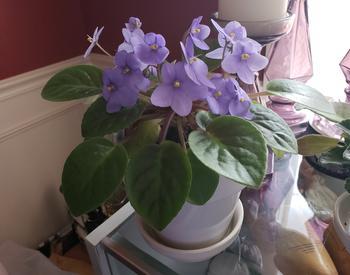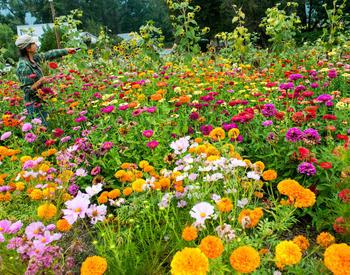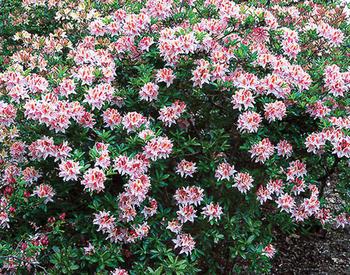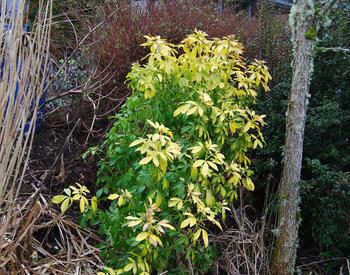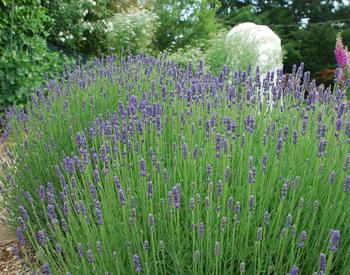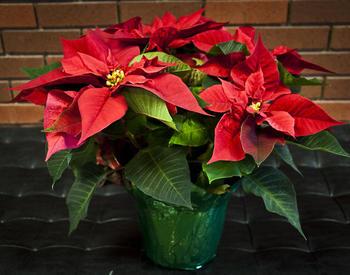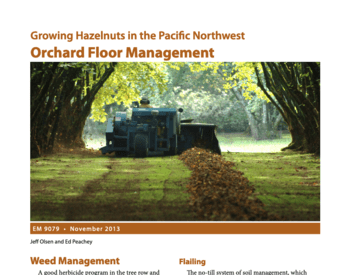Transcript
243 - Bee Friendly Gardening
Andony Melathopoulos: [00:00:00] From the Oregon State University Extension Service, this is pollination, a podcast that tells the stories of researchers, land managers, and people like you who are making bold strides to improve the health of pollinators. I'm your host, Dr. Apolis, associate Professor of Pollinator Health in the Department of Horticulture.
Late summer bloom in our pollinator gardens here in the Pacific Northwest is going full hog. All the composites are out the asters golden rod on the east side of the Cascades rabbit brush, and they're bringing forward a whole bunch of our late pollinator community in addition to the, honeybees, for example and other.
Social bees that are trying to get themselves all stocked up before winter comes. I thought this would be a great opportunity to take stock of our gardens. And I've got a series of episodes coming up here in September that are gonna feature gardens and garden [00:01:00] initiatives to take your garden to the next step because fall is a great time to get in perennials and shrubs.
Let them set down their roots before, as the winter rains come in it's a great time for shrub and perennial establishment today I'm gonna start this series off with a very special guest Sarah Wittenberg. I've been trying to get Sarah on the episode for a while. She is very busy.
She heads up pollinator partnerships, be Friendly Garden Initiative and she's been with pollinator partnership for a, a number of years working. In the ag sector as one of the N R C S pollinator liaison positions, but she is now heading up the Be Friendly Garden Initiative. So in this episode, I'm gonna hear a little bit about this initiative, how you might be able to get involved, but also some of the resources that are available for those of you like me, who wanna take this fall as an opportunity to retool our pollinator gardens and bring 'em to the next level.[00:02:00]
So without further ado, let's talk with Sarah Wittenberg from Pollinator Partnership this week on pollination.
Hey, Sarah, welcome to Pollination.
Sara Wittenberg: Hey, and Doni, thanks for having me.
Andony Melathopoulos: I understand you're all the way down in Arkansas all the way up in Oregon. How is it down there today?
Sara Wittenberg: Actually, it's beautiful today. It's 73 degrees dropped from 99 for the past oh, months.
Andony Melathopoulos: How are the gardens in Arkansas?
Sara Wittenberg: The gardens are in their prime right now, so looking beautiful.
Andony Melathopoulos: We wanna talk about gardens today, and I specifically about an initiative from pollinator partnership, the Beef Friendly Gardens, and people listeners will remember we had a previous episode with Miles Daikin talking about beef friendly farming.
Which was a great program to certify growers who go the extra mile to help pollinators. But clearly. There's also many people in their gardens who are doing stuff to help bees and butterflies and [00:03:00] moths. Tell us, so you've got this program, which is geared specifically to gardeners.
Tell us what was the kind of impulse, why did this program develop?
Sara Wittenberg: Yeah, definitely. We were getting a lot of interest from a lot of individuals who really wanted to be a part of what we were doing, but they weren't growing anything in a commercial setting. So we a.
That's the impetus behind Be Friendly Gardening. BFG is a membership based program, a way to be part of a larger community of people trying to do the right thing for pollinators. By creating habitat you can make a big impact by implementing simple, positive and incremental changes on your property.
And when you show your neighbors and your community that you're supporting pollinators. Do something too, create an exponential impact for your efforts. And yeah, I also to our program that you mentioned, we all eat and we all know that pollinators are imperative to our food supply. So be friendly.
Farming supports farmers who are making the effort to [00:04:00] produce our food in a sustainable way, and we really wanna draw that connection back to home gardeners as well. Basically, we can all do something on the scale at which we are working to be a part of a concerted effort to better our planet. Whether you're planting milkweed from monarchs in your yard, or installing a permanent hedgerow to provide bee habitat on your almond farm.
Basically we're all in this together and we can all support each other's actions.
Andony Melathopoulos: That's interesting. So there it's the way in which be friendly gardening and be friendly farming are conceptualized in some ways is that there. There's a kind of connection between them often, oftentimes I do think, the prevalent way of thinking about it is my garden is, bee habitat.
Whatever goes on outside of city limits is not, and the idea that you have some affinity or connection. To an almond grower or a blueberry grower who's probably planting the same plants that you are. It's I'm looking behind your head and there's an naster with an aga possum bee on it, [00:05:00] and it's like every, especially here in Oregon, both farms that are doing be friendly, habitat and gardens are probably relying on our, our native as here, our native purple as are going strong.
Sara Wittenberg: Yeah, definitely. It's really all about scales, right? Whether you're growing blueberries in mass, or whether you have two or three blueberry bushes out in your own in your own yard and garden, really a lot of those practices can be the same. They can just be scaled up or scaled down. So we really do wanna draw that connection between, what the farmers are doing to grow food for us.
We can do right here at home, and we can all, do our part.
Andony Melathopoulos: I love the idea of scaling, upper scaling down, and one might think. The naturally a garden is a simpler proposition than like a, a big, but it isn't like getting, if you've had a, a bought a property recently, it's got turf and you wanna transition it into a pollinator, it is, it is not a simple proposition.
And I all often see people who do it. You, I always love [00:06:00] taking a walk on these warm summer nights and you can just see what people are doing. And some people are really successful, but, it's oftentimes that's the brilliance of a good garden. The kind of work and thought and preparation into it is invisible.
It just looks, it just wow. So tell us about what are some of the challenges that, you've, you're talking to a lot of gardeners, what are they? Running into. And how does your program help them get from law to that? Thing that you see on your summer evening stroll?
Sara Wittenberg: Yeah.
It's heartening to see the interest growing among the public to wanna do something, to take action. But often, people just simply don't know where to begin. Yeah. And it may feel overwhelming. It may feel like, I'm not qualified or I don't have the knowledge to take on the task.
Building a pollin too big of a My advice, although site prep and, all of these nuances are very important, but sometimes you can get really just too caught up in that [00:07:00] and it can prohibit you from doing anything. Yeah. So my advice really is just to dive in. What's the worst that could happen, right?
Maybe you don't see the beautiful gardens that you've just painted a picture for us of, but it'll come time. You really can't mess up even if you plant purple cone in a pot. Something is gonna benefit from it uhhuh. So if you plant an herb garden with parsley and dll, then you'll likely host the black swallowtail caterpillar.
So it can be as simple or as complicated as you like. My advice is just to start, I would say to start small containers on a patio or a small plot of land in the corner of your yard. So just pick a spot. Select some pollinator friendly plants and plant them. And the cliche really is true. I think that if you plant it,
Once you plant a few plants and you start to see the fruits of your labor, you'll wanna plant more. Hence the beautiful gardens that you are now painting the picture of, they will come. So I recommend for those of you [00:08:00] listening maybe who aren't sure what to plant, you can visit our website, which is a great resource and has lots of great resources on it, which is just pollinator.org.
Check out our planting guides and our garden recipe cards. So the garden recipe cards are a great starting point. They're regional, so you'll wanna find the one for your region and it's just a guide on a few plants to use That will bloom from spring all the way through fall, and they'll get you started and then you know from there, because you'll be addicted.
If you want more, you can use our planting guide. And you just enter your zip code to get a curated list of plants for where you live. So you can add every more, or e every year as you expand, you can add more plants to fill out your garden. And one thing that my kids and I really enjoy doing are researching host plants.
So certain butterfly larvae, for example, will only eat certain plants and they require those plants in order to lifecycle. Monarch butterflies, the classic one. They'll only lay their eggs on milkweed. [00:09:00] And it's estimated that we need something like 1.6 billion stems of milkweed on the North American landscape to sustain our monarch, which are in trouble, by the way.
That's a lot of milkweed and we can all plant milk. We in our spaces to help reach that goal. We have three species here in our yard, but we also enjoy finding out what other host plants will support pollinators and adding those to our yard. And then if we plant it, they will come. They always seem to do.
So we watch the caterpillars that end up utilizing those host plants. So we've added for the swallow tail, we've added spice, the cater.
Just name. We really just hope you
gardening and be a, you undergo the adventure of pollinator gardening.
Andony Melathopoulos: I think that is great. And I do think that is being able to have a palette, because you do start with certain plants and then I think it is that kind of iterative process. You're like, oh, [00:10:00] I'm going to pick up a book on butterfly host plants.
It's oh geez, if I just had. And now you, my ignorance of butterfly host plants comes through this. Then I would, I could start to see these things. I really love that idea. And I, there's somebody in New Mexico we're trying to arrange a podcast with who's gone off. In a deep way.
I was gonna off the deep end, but in a deep way documenting the biodiversity on their property. And I can see how it starts. It is this kind of it is one of those things that kind of allows you to Move along. And I have not gardened that much in my life. I'm just starting to and I started just the way you described in containers, which was the simplest way.
It's, for a fool like me, I could, it pulls off. I got the plants there. There's not a lot of weeded competitions. It's got great soil. It looks good and I felt successful, but I could see how each of those steps, you get some success. You learn a little bit more. You [00:11:00] tear some plants out, you put new plants in.
It's this and having having a kind of roadmap where you can type your zip code in and then you can see, okay, here my options. And explore what could be more pleasant in In your life. Yeah.
Sara Wittenberg: You're so right. Like mentioning the host plants, now I'm getting my kids involved, and it becomes a game to some effect.
Milkweed was the segue to everything else for us. We started with Milkweed for Monarchs, and then it was like sure enough they showed up. So what else can we do? Oh yeah. We picked up a book on, native plants for pollinators and started. What could we get for these?
And so we'd go buy a plant that the local native plant fell and one thing led to another. And yeah, milkweed and then, a, I remember Astor was another kind of intro plant for me, and it was just dripping with pollinators. And I thought if I can do this, of course it wasn't blooming here in Arkansas until well into the summer.
I thought what can I add earlier in the year? So I started experimenting with other things. It de it definitely. [00:12:00] It's definitely trial and error though. And you definitely learn along the way. I put a beautiful cardinal flower in the middle of my garden, not realizing it was a biennial.
And two years later it had done its thing and it was gone. And then I had a hole. And so I, I had to figure out what am I gonna put in its place. So it's always evolving. But that's the fun of it, I think.
Andony Melathopoulos: How long has be friendly gardening been a thing?
Sara Wittenberg: Friendly garden has been a thing since 2020 and Okay.
I have been at the helm for about a year now,
Andony Melathopoulos: okay. Alright. So relatively new. But you probably are starting to run into some gardens of note. So tell us a little bit about some of the gardens that you've seen where, you see it and it's wow. Like the, my stroll kind of garden definitely come across my
Sara Wittenberg: strolls.
I'll say that we have beautiful photos submitted of people's beef friendly gardens from all over the United States and Canada. And I'm so lucky to be able to field these applications and be inspired on a daily basis as I get to see what people are doing for pollinators and get ideas for my [00:13:00] own garden as I, as they roll in.
But in.
We also have some more public gardens. And so I always enjoy seeing these and seeing how people are, using gardening as a way to, to bring communities together and bring people together for a larger effort. So one example is the Woods Friendly Community Garden, which is in Charlotte, North Carolina.
Started by a husband and wife team who had a passion for gardening, and they wanted to turn that passion into a way to serve their community. So by empowering people to grow their own fruits and vegetables, coupled with hosting gardening classes. They're helping food insecurity in their neighborhoods.
They also are harvesting honey from their own beehives and using those berry bees to pollinate the crops that they're growing. So I love the concept of their motto. A Beautiful garden is a work of heart. And when they applied, they submitted, a plethora of wonderful photographs showing lots of different people coming together in their garden to do this important work.
Andony Melathopoulos: So lemme get that straight. They, so they [00:14:00] started, there was a community garden. They just took it on, started providing classes providing technical support and then, I can see how that's a work of heart.
Sara Wittenberg: Isn't that a great motto? I love the concept of that yeah.
And I wish I could paint a picture of the pictures the photos that they submitted because they really, it, it really was just very inspiring.
Andony Melathopoulos: All right. Tell it we wanna hear more. Yeah.
Sara Wittenberg: Yeah. Another one, Community based garden that stands out is Farm City. Detroit is a project of the organization called Motor City Blight Busters.
So thereby line is revitalizing Detroit neighborhoods. And the larger organization which I gleaned all of this from their website they rely upon community partners and volunteers to transform vacant properties into, lively community spaces. Demolish or convert you. Buildings into safe, affordable housing, for example.
They provide lots of community programs from health screenings to skills trainings to [00:15:00] housing and veteran services. And then most notably, as it relates to be friendly gardening is their, one of their initiatives, which is called Farm City Detroit. And so they took a. Abandon end dangerous properties and they turn them into a thriving community garden.
And so from this garden, the locals can come and obtain food. So they have an orchard. The orchard obviously is gonna produce food. But we also know that trees provide so many other benefits, whether it's shade and the reduction of urban island effects. Absorbing carbon dioxide, reducing stormwater runoff, just to name a few.
So some really cool things there going on in Detroit, that farm city, Detroit Garden. Yeah, and then one of our more recent ones was the Lake Superior Zoo in Minnesota has joined beef friendly gardens. So I guess, I just, I would be remiss if I didn't take this opportunity to just let listeners know that pretty much anyone who isn't growing in a commercial agricultural setting is eligible to join at the D friendly gardening.
[00:16:00] And if you are growing in a commercial agricultural setting, then you can check out our Be Friendly Farming program. So pretty much no matter who you are, we're gonna have a spot for you here and we hope you'll come on over. But homeowners and backyard gardeners of course, are welcome in our program, but doesn't just stop there.
You can not only, do it in your own space, but you can utilize those spaces that you're connected with in your community to bring those into the program too. So it can be school campuses, it can be churches, places of worship, botanical gardens, and city parks. So pretty much if you have a patch of lands and you plant for pollinators, and we would love to have you.
So we like to say anyone with influence over a patch of land can make a difference.
Andony Melathopoulos: Okay, so just to get this straight, so there's two parts to this. There are the resources that are available that pollinator partnership puts together, but there, the Be Friendly Garden initiative is a way to I guess highlight that you've, a garden is achieved like a certain level of what is, how [00:17:00] does one, what is, what do you have to do to become a be friendly garden?
Like what's the. Tell us the steps. You wanna know the criteria or what's involved? Yeah. What's the criteria? What makes a beef? Maybe that's just a great way to put it as well what makes a beef friendly garden?
Sara Wittenberg: Yeah. So to become a beef friendly garden, you really need to provide or consider three different criteria.
So you need to provide floral resources so that pollinators have, food. They need to bloom across season. So spring through fall so that when they emerge in the spring, all the way until, they go dormant or migrate, in the case of a monarch in the fall, they can find something to eat to sustain them.
You need to provide nesting habitat because in order to complete their lifecycle in your space, they need to be able to safely nest and have offspring, and then you need to reduce or preferably eliminate your chemical use. Your pesticide, you, so that they have a safe place in which to do this. So once you've met all three of those criteria, then you are eligible to [00:18:00] join our program.
Andony Melathopoulos: Okay. And how do you sign up? How does, how do you,
Sara Wittenberg: yep. So you go to, Be friendly gardening.org. And there you will find the application link. There is a $20 annual membership fee. You meet those three criteria and you pay the annual membership fee. And that just helps us to grow and develop the program to expand our reach and therefore our impact develop more habitat, which is why we're all doing this.
So yeah, we.
You already have this habitat you'll enroll today. But if you aspire to have a Be Friendly Garden, maybe you don't yet, that's okay too. We don't wanna lose you. So please bookmark our website, which once again, it's be friendly gardening.org. And then just like I said, just get started. Just dive in, use the resources available to [email protected] and bookmark.
Be friendly gardening.org, and then come back once you have your plants in the ground and join. So
Andony Melathopoulos: I guess that's the thing that, so let's [00:19:00] say you're starting out, you're not ready to it's like you've got to a level 'cause you're gonna have certain standards. What what are the standards?
Like how do you know what you Yeah, go ahead, get more into detail about what you need to do. So it has to be, you have to have bloom across multiple.
Sara Wittenberg: Yes. Yes. So again, I those resources that you directed people to earlier, if you wanted to go on there and you wanted to get started on your garden.
So we're getting into the nitty gritty here of site prep and things, is that, yeah. You, you definitely wanna do a little bit of research on site prep. That's so important. It's gonna really pay off in, in dividends later if you do your research up front because. Battling the weeds and the things that are just a constant vein to a gardener's existence, right?
So do your due diligence, do some site prep. Get rid of any invasives that, are there any when I say quote weeds, the things that are gonna be invasive and outcompete the plants that is are what you're wanting. So eliminate that. And there, there are various ways in which to do that, which You can dig into our website a little bit and [00:20:00] decide your approach to that.
But once your site is prepped and you've selected your plants, you're gonna wanna do a little consideration of things like, light level, wherever you're gonna put your garden. Pollinator plants usually like sunny spots, so you're probably not gonna wanna put it, under a bunch of shade trees.
So you really want remove the soil. You can start with seeds, although there are different considerations for if you so seeds or you start with, actual plants you go with method. Then sometimes, Probably plant over the winter. A lot of people like to do like a winter seed sewing because they get that freeze thaw cycle, which helps them to germinate and and make sure that they are into good contact with the soil, like good bare soil seed to soil contact.
And then if you do plugs, you can plant those in the fall or the spring, you'll just wanna make sure that they're well watered throughout the first season until they become established. And then, if you're going with. It's really the gold standard natives for your areas.
We, we certainly still advocate for [00:21:00] non-native, non-invasive species. Those are totally fine. I know people have a lot of garden favorites as long as they're appealing to pollinators and you can incorporate those too. But just sometimes you can be aware that the native plants, sometimes because they're native to your area, they're well.
They may require a little less care from you in the long run, although you're gonna wanna water them until they're established. My gardens, once I got 'em going through the first year, I do nothing. They just go on their own. So there is that nice added benefit for the native perennials as it's plant them.
And then to some extent, after the first year, forget 'em and let 'em go. You have to maintain the weeding and things like that.
Andony Melathopoulos: Yeah, so there's not a requirement to be all native plants. I know for example, I've got a lot of Midwestern natives as this time of year, just in terms of composites.
And they are waterwise, deep rooted. I have all sorts of wild bees going to them, but they're just add some color, but they're not from here. But that's not you don't, you're not disqualified if you have some. [00:22:00] Plants that are not from your region?
Sara Wittenberg: Nope. Nope. Native plants are not a requirement.
It's something to strive for, but we really just caution against the invasives, the things that have become problematic in our environment. We don't wanna condone that. We're adding those into your space.
Andony Melathopoulos: What if you have, I guess here's another question for certification. What if you have a, you ha do have a pest problem.
Let's say right now we have a. Oregon is facing emerald ash borrowers coming through, and some homeowners may not be able to take a tree out and they have to treat the tree. Or are those, are there any restrictions on that if you do it responsibly?
Sara Wittenberg: So again, we really, We don't wanna advocate for an all or nothing approach, and we don't wanna alienate anyone.
We just, we wanna do better. We wanna take our spaces and we wanna do better than what we're already doing. So as long as we're moving the needle in that direction, then that's really what we're focusing on. And that's one of our goals is to get the educational resources out there to help people to do that, to make those better choices, right?
So that's why we say reduce or eliminate chemical use. Again elimination would be the goal, [00:23:00] but if you're moving the needle towards. The reduction part of things. Yeah. Yeah. And you're so I agree with
Andony Melathopoulos: this.
Sara Wittenberg: Yeah. If you're going to use a chemical for maybe a very targeted approach, again, chemicals in and of themselves aren't necessarily bad.
There's a place for them, but we think that sometimes, Especially in the home garden, they may be use. There's definitely overuse of chemicals and then the idea, oh, for sure the prophylactic use of chemicals. Maybe hiring a company to just come in and spray on a very regular basis so that you have the lawn monoculture is not necessarily what we're advocating for.
But that doesn't mean that there might not be. Uses for chemicals in a situation like you propose where you have a significant pest problem, and maybe to move that needle towards the more you know native habitat that you're going for, you might have to remove a pest in that process. So just being very mindful of your chemical use.
Very intentional, always reading label directions, applying when pollinators aren't active so that, you're minimizing their contact with it. Integrated pest [00:24:00] management is really the direction that we go.
Andony Melathopoulos: And I remember talking with miles about be friendly farming, same thing, integrated pest management.
I, and I really agree with that. I think that is, one of the things that we advocate here in Oregon, sometimes in gardens I think people can't recognize. Is that an abiotic problem or is it a disease and First step is taking, calling the master gardeners with some fo, you can go to a ASK Extension, here's my problem.
And oftentimes, a pesticide will not solve that problem. Or it's just like a, that plant should go. You know that plant is always gonna have problems. Pull it out, put in. There's so many good plants that can look the same stature, bloom times the same, and will never have a problem. And like knowing when to cut your losses.
Yeah,
Sara Wittenberg: that's, those are all really good points and I think, Use, use the tools available to you and make chemicals your last resort, right? Yeah. So like you
resort, you've [00:25:00] tried.
Andony Melathopoulos: I imagine that while a lot of people I mean I, after you go through this process and you certify and you get a sign you get a sign on your property. I imagine that is exciting to people because it becomes a way of share, you advertise, I'm doing this, and then maybe other people in your community drop by and you talk, and I tell us a little bit about how you envision, be friendly gardening.
Sort of building a network of peers, of people who can share ideas and help each other.
Sara Wittenberg: Yes. Community building is one of the primary purposes of be friendly gardening, so it's, it's a way to connect like-minded people with others working towards the same goal. A way to collaborate, share ideas.
And just provide support and encouragement. So we provide multiple avenues for our members to connect with each other and share their stories. When you sign up for B F G, you have the option to have your garden included on our map, so that way members can see where [00:26:00] other members are located around North America.
Andony Melathopoulos: That's great.
Sara Wittenberg: Yeah, maybe there's a fellow b f G in your community and you wouldn't have known that, but maybe you see them on the map. And so it really creates that, sense of place I think, amongst our members. Upon acceptance into the program, you'll receive a digital welcome packet, and through this you will gain access to our members only webpage which is the hub of all things B F G.
You'll be able to join our B F G Facebook page. And there you can share photos of your garden interact, by commenting directly on other members' posts. We will encourage you to join our iNaturalist project and upload observations of the critters that you see utilizing your B F G. This is a way for.
And then you mentioned the sign. So when you sign up, you'll receive a coupon code for a beef friendly garden sign to spread the word about the good work you are doing. So this is a, these signs are great conversation starters with your neighbors. Get the conversation started and who knows, maybe convert your neighbor over to doing their own backyard pollinator [00:27:00] habitat.
You'll receive a monthly newsletter and via the website you'll have access to all the past newsletters too. There's an archive on there so you can go back, and read through those at your leisure. We encourage members to submit photos and articles for the newsletter so you have one more chance to tell your story.
And you can access merchandise such as our beef friendly gardening hat, which is exclusive only time members. We have webinars posted on the member page on topics such as habitat creation like we were just referring to. So if you wanted a more in depth how to, we have, a technical habitat creation series on there.
You could watch some webinars on that and learn how to, that's great. Another one on integrated pest management, which we also were just referring to. So some nice, webinars on there available to members. And at times you'll have access to special opportunities. So just last month we closed a Toyota sponsored native seed grant that the FG members who applied for that seed would get priority on.
So some priority access things [00:28:00] for members. Yeah just really focus on that community aspect like you mentioned.
Andony Melathopoulos: That's fantastic. That's a lot of different parts and I remember the seed grant popped up a few months ago and that's great to know that, you can get some You can apply to get some seed that's specific for your area and but you can also get the sign.
And also I personally love the idea that I'm actually gonna type in Corvallis and I'm gonna go on a little walk when I take my stroll this evening, I'm gonna go. Look for all the Be Friendly gardens in Corvallis, but there you go. Let's take a quick break. We're gonna come back. We have this section that we do with our guests.
Looking forward to seeing your answers, Sarah.
Okay. We are back. So book recommendations. Sarah, what do you have as a recommendation that you want people to read?
Sara Wittenberg: Okay, so I struggled with this one a little bit. I decided in the end not to give you a pollinator specific book but instead I went with one that I thought was just, Such a foundational book for understanding ecosystems and [00:29:00] ecology.
I think anyone interested in the natural world should read it. It was one of, one of the first books that I read when I, was in college formally training to become a biologist, and it's a San County Almanac.
Andony Melathopoulos: Oh, fantastic. Which is Aldo Leopold, right? That's it. Yep. So that I've never read it. So tell us a little bit about
Sara Wittenberg: why.
Oh, it's just, oh gosh, where do I begin? It's so fantastic. It's his journey of taking his own farm in Wisconsin and converting it into, everything that we all are striving for, so I just found it so inspirational to, to see, the tenets that he used and the struggles that he had, and yeah you definitely
Andony Melathopoulos: should read it.
Fantastic. Thank you for putting that on my reading list and on everybody else's reading list. I guess the next question I have for you is Do you have a go-to tool for, I don't know, for being a B friendly garden coordinator, or maybe just a gardening tool [00:30:00] or what's your go-to tool?
Sara Wittenberg: Yeah.
This is probably gonna seem a little stale, but I really just have to highlight those ecoregional planting guides again, because in my job, The two questions that I always get are, what should I plant? And then now where do I go get those plants? And I don't have necessarily an easy answer for part two because it's so regionally specific, but but what's a plant is easy by going to our planting guides. So like I said, again, if you go to pollinator.org, you go up to that resources tab, you find our planting guides, it's as easy as just putting in your zip code and you get this plant that's tailored to your region.
Andony Melathopoulos: That is great and it's nice to have something very specific.
Sometimes those guides are just, too broad and it's nice to have something that kind of considers how that, there must be a lot to have so many guides. There must be like a constant effort to research these things and go through 'em. Oh, I imagine it took a decade of work. It
Sara Wittenberg: was a big task and there were lots of different people and partners involved in putting [00:31:00] that together.
Andony Melathopoulos: Great. So we've got your go-to tool and the last question, which everybody's like squirms to try and like answer is your favorite pollinator species, especially when you're in, when it comes to P two it's all pollinators, so you can't do what I do and just figure out a b, it's gotta go like the whole round.
So what. What's your favorite? So let's see, your favorites.
Sara Wittenberg: My favorite is plural, right? As an ornithologist, I would
Andony Melathopoulos: the
Sara Wittenberg: right.
Many people think pollinators and they think insects, right? But pollinators are such a diverse group. Other than insects, of course, like I already mentioned, there's birds and did you know that there are actually like 2000 species of pollinating birds in the world? Not just humming birds things, likes and Oh, I didn't know that.
Yeah. I just think, I don't know, I to veer, away from the norm. There's mammals. The rough lemur actually is the world's largest pollinator in Madagascar. It climbs up in [00:32:00] these palms, like 40 feet above the forest canopy and rips them apart, and it pollinates in the process.
And then wow. Yeah, there's this little. Honey possum in Australia, that's only three inches long. And it eats, parts of the eucalyptus flour. And bats. Of course, everybody probably, if you said, what is a mammal, that pollinates would think of bats and they say bats. Yeah, and they're they
Andony Melathopoulos: would not say lemur, I'll tell you that.
Sara Wittenberg: They would probably not say lemur. And I, not even that long ago found out about this tiny honey possum. I didn't even know that critter existed, and it's so cute. You should look it up. But yeah, that's, but there's reptiles that, there's, and Gs, and I'm sure probably lots more and more tropical places.
Even under water, even under, we've discovered that there are seagrasses that are pollinated by tiny crustacean. So that was crazy. But if I were to choose an inside pollinator I would probably say, like right now I'm really in [00:33:00] love with the hummingbird clearing m I think that those little stinks MAs, or big stink SMAs, I guess I should say, are so cool.
And maybe because, I, they, because they look, more a
it. When I see one.
Andony Melathopoulos: I remember, I, I think it, I, it seems strongly associated for those of the Oregon listeners on wax current, there's one that you see and that I remember seeing. It was just like, wow, that is the craziest looking be, I can't place it in any general, what is this thing? And that was what it was.
I'm so glad I gave you liberties with this answer 'cause you really took it in a place that was wonderful. And it's been a wonderful conversation. I'm so glad to hear about be Friendly Gardens and how things are how it's all pulled together. And I think for many of our listeners this is probably, a resource that they've been looking
Sara Wittenberg: for.
I hope so. Thank you so much for having me. I really enjoyed it. Take care. Thank you. Bye-bye.
Andony Melathopoulos: Thank you so much for listening. Show notes with [00:34:00] links from each episode are available at the website pollination podcast dot Oregon state.edu. I also love hearing from you, and there's a form at the website where you can pop in and say hello and give me feedback.
If you wanna support the show, remember to leave a rating on iTunes, Spotify, or whatever podcast mothership you use. And finally, if you have the means and you want to help support my Lab's effort to document Be Biodiversity Oregon Visit. Oregon be atlas.org and follow down to the donate button where you can make a tax deductible donation to the Jerry and Judith Paul native pollinator endowment.
Every little bit helps. See you next episode.
With the season for pollinator gardening winds down, it is a great time to start planning your garden for next year. In this episode we we learn about a national program to connect gardeners together and provide them with resources to up their pollinator gardener game.
Links:
Bee Friendly Gardening Website
Sara's Book Recommendation: A Sand County Almanac (Aldo Leopold, 1959)
Sara's Go-To-Tool: Pollinator Partnership Ecoregional Planting Guides
Sara's Favorite Pollinator: "As an ornithologist, I'd have to go with hummingbirds. In Arkansas we pretty much get Ruby-throats, and I'm always pleased to see them utilizing my pollinator garden. As far as insects, right now I'm really into hummingbird moths of the genus Hemaris. I don't see them very often, but when I do they are really mesmerizing".
About our Guest: Sara has a BS in Zoology (Auburn University) and a MS in Biology (University of Arkansas). Her experience includes interning at the national zoo in Costa Rica, directing the rehab program at the Southeastern Raptor Center, running a HawkWatch banding station in the Florida Keys, tracking gopher tortoises, conducting breeding bird surveys for the USFS and Sandhill Crane/Sage-Grouse surveys for the USFWS, and assisting with Cornell University’s search for the (extinct?) Ivory-billed Woodpecker. She has taught/coaches science at two public secondary schools, and believes strongly in sharing her passion for the natural world with the next generation of conservationists! Her favorite quote is by Baba Dioum: “"In the end we will conserve only what we love, we will love only what we understand, and we will understand only what we are taught." In her free time, Sara enjoys reading, hiking, birding, traveling, gardening, and exploring the beautiful Ozark mountains with her husband and two children. Sara joined Pollinator Partnership in early 2020 as the Project Wingspan Arkansas State Coordinator, then soon stepped into the role of AR NRCS Pollinator Liaison. Most recently Sara became the P2 Bee Friendly Garden Coordinator and is excited to grow the program and connect with those seeking ways to help pollinators on their own property! If interested in joining the Bee Friendly Garden (BFG) program, please contact Sara.

